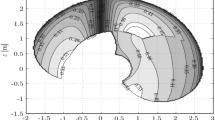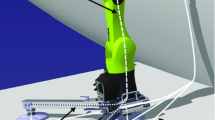Abstract
Since the introduction of robots in the automotive industry for pick and place tasks, new technologies have been developed in order to adapt robots to different manufacturing processes. Among them, the use of robots as machine tools is a technological trend that demands further investigation. Industrial robots with 6 DOF (degrees of freedom) in a serial kinematic chain have larger workspace and more flexibility, when compared with CNC machines. However, robots’ stiffness is lower than that of CNC machines. Consequently, vibration problems are expected, which can have a direct impact on the quality of the machined workpieces. This work proposes a method to evaluate and customize the use of a COTS (commercial off-the-shelf) robot equipped with a spindle for machining processes. It aims at improving the machining processes based on the measurement of the workpiece waviness and explores the fact that the accuracy and rigidity of industrial robots with serial kinematic chains behave in an anisotropic way, according to the robot pose and the cutting force direction. The method is composed of a set of five experiments and is applied to the evaluation of a robot machining aluminium workpieces. The results allow the identification of the relevant factors that affect the surface quality of the workpiece and recommend the best robot configuration for meeting the waviness requirements of the workpiece. Even though the application case describes the machining of aluminium workpiece, the proposed method is generic enough to be applied to different workpiece geometries and materials.
Similar content being viewed by others
References
Depree J, Gesswein C (2016) Robotic machining white paper project. Robotic Industries Association. http://www.robotics.org/robotic-content.cfm/Robotics/Halcyon-Development-RIA/id/43
Cordes M, Hintze W (2016) Offline simulation of path deviation due to joint compliance and hysteresis for robot machining. Int J Adv Manuf Technol, pp 1–9, DOI: 10.1007/s00170-016-9461-z
Belchior J, Guillo M, Courteille E, Maurine P, Lotoing L, Guines D (2013) Off-line compensation of the tool path deviations on robotic machining: application to incremental sheet forming. Robot Comput Integr Manuf 29:58–69. doi:10.1016/j.rcim.2012.10.008
Klimchik A, Ambiehl A, Garnier S, Furet B, Pashkevich A (2016a). Experimental study of robotic-based machining. IFAC-Papers On Line, vol. 49, n.12, pp. 174–179. DOI: 10.1016/j.ifacol.2016.07.591
Iglesias I, Sebastián MA, Ares JE (2015) Overview of the state of robotic machining: current situation and future potential. Procedia Engineering 132:911–917. doi:10.1016/j.proeng.2015.12.577
Tunc LT, Shaw J (2016) Experimental study on investigation of dynamics of hexapod robot for mobile machining. Int J Adv Manuf Technol 84:817–830. doi:10.1007/s00170-015-7600-6
Barnfather JD, Goodfellow MJ, Abram T (2016a) Development and testing of an error compensation algorithm for photogrammetry assisted robotic machining. Measurement 94:561–577. doi:10.1016/j.measurement.2016.08.032
Mejri S, Gagnol V, Le TP, Sabourin L, Ray P, Paultre P (2016) Dynamic characterization of machining robot and stability analysis. Int J Adv Manuf Technol 82:351–359. doi:10.1007/s00170-015-7336-3
COMET (2012) Robots change the industrial future replacing the CNC machines. <http://www.cometproject.eu/publications/gizelis-robots-replace-cnc-machines.pdf
STÄUBLI (2008) Stäubli: robotics and machining. http://www.staubli.com/index.php?eID=tx_nawsecuredl&u=0&file=fileadmin/user_upload/staublicom/robotics/robot_arms/products/pdf/RX170HSM_062008_GB_D18157504.pdf&t=1369831419&hash=b39c15ef09088e4d3256d8bc7e9859c941156174
ABB (2016) IRB 6660 for pre-machining. http://new.abb.com/products/robotics/industrial-robots/irb-6660-for-pre-machining
COMAU (2012) Comau robots: your robotized solution. http://www.comau.com/DlDownload/Comau%20Robotics%20Brochure/Brochure_gamma_Comau_Robotics.pdf
KUKA AG (2012a) Milling 8 kW standard. 105
KUKA AG (2012b) Kuka force torque control 3.0. 75
Chen Y, Dong F (2013) Robot machining: recent development and future research issues. Int J Adv Manuf Technol 66:9–12. doi:10.1007/s00170-012-4433-4
Olofsson B, Sörnmo O, Schneider U (2011) Modeling and control of a piezo-actuated high-dynamic compensation mechanism for industrial robots. IEEE/RSJ International Conference on Intelligent Robots And Systems (IROS), pp. 4704–4709 DOI: 10.1109/IROS.2011.6094846
Sörnmo O, Olofsson B, Robertsson A, Johansson R (2012) Increasing time-efficiency and accuracy of robotic machining processes using model-based adaptive force control. The 10th IFAC Symposium on Robot Control. DOI: 10.3182/20120905-3-HR-2030.00065
Coelho RT, Rodella HHT, Martins VF, Barba R (2011) An investigation into the use of industrial robots for machining soft and low density materials with HSM technique. J Braz Soc Mech Sci Eng, vol. 33, n. 3, pp. 343–350 DOI: 10.1590/S1678-58782011000300010.
Slamani M, Gauthier S, Chatelain JF (2015) A study of the combined effects of machining parameters on cutting force components during high speed robotic trimming of CFRPs. Measurement 59:268–283. doi:10.1016/j.measurement.2014.09.052
Guo Y, Dong H, Ke Y (2015) Stiffness-oriented posture optimization in robotic machining applications. Robot Comput Integr Manuf 35:69–76. doi:10.1016/j.rcim.2015.02.006
Barnfather JD, Goodfellow MJ, Abram T (2016b) A performance evaluation methodology for robotic machine tools used in large volume manufacturing. Robot Comput Integr Manuf 37:49–56. doi:10.1016/j.rcim.2015.06.002
Dumas C et al (2011) Joint stiffness identification of six-revolute industrial serial robots. Robot Comput Integr Manuf 27:881–888. doi:10.1016/j.rcim.2011.02.003
Abele E, Weigold M, Rothenbücher S (2015) Modeling and identification of an industrial robot for machining applications. Annals of the CIRP 56:387–390. doi:10.1016/j.cirp.2007.05.090
Pan Z, Zang H, Zhu Z, Wang J (2006) Chatter analysis of robotic machining process. J Mater Process Technol 173:301–306. doi:10.1016/j.jmatprotec.2005.11.033
Zargarbashi SHH, Khan W, Angeles J (2012) Posture optimization in robot-assisted machining operations. Mech Mach Theory 51:74–86
Klimchik A, Ambiehl A, Garnier S, Furet B, Pashkevich A (2016b) Experimental study of robotic-based machining. IFAC-PapersOnLine 49-12:174–179
CORDIS (2010) COMET Project: plug-and-produce COmponents and METhods for adaptive control of industrial robots enabling cost effective, high precision manufacturing in factories of the future. http://cordis.europa.eu/search/index.cfm?fuseaction=proj.document&PJ_RCN=11467246
CORDIS (2012) HEPHESTOS project: hard material small-batch industrial machining robot. http://cordis.europa.eu/search/index.cfm?fuseaction=proj.document&PJ_RCN=13114066
Schneider U, Drust M, Puzik A, Verl A (2013) Compensation of errors in robot machining with a parallel 3D-piezo compensation mechanism. Procedia CIRP 7:305–310
Katz R, Srivatsan V, Patil L (2011) Closed-loop machining cell for turbine blades. Int J Adv Manuf Technol 55:869–881. doi:10.1007/s00170-010-3138-9
Bottero A, Gerio G, Perna V, Gagliano A (2014) Adaptive control techniques and feed forward compensation of periodic disturbances in industrial manipulators. Mechatronic and embedded systems and applications (MESA), IEEE/ASME 10th International Conference on. DOI: 10.1109/MESA.2014.6935612
Slavkovic NR, Milutinovic DS, Glavonjic MM (2014) A method for off-line compensation of cutting force-induced errors in robotic machining by tool path modification. Int J Adv Manuf Technol 70:2083–2096. doi:10.1007/s00170-013-5421-z
Grzesik W (2008) Advanced machining processes of metallic materials: theory, modelling and applications. Elsevier, Amsterdam 472 p. ISBN-13: 978-0080445342
Murthy ST (2010) Textbook of elements of mechanical engineering. New Delhi: 266 p. ISBN-13: 978–9380578576
DIN EN ISO 4288:1998 (1998): Geometrical product specifications (GPS)—surface texture: profile method—rules and procedures for the assessment of surface texture
Montgomery DC (2013) Design and analysis of experiments, 8ed edn. Wiley, Hoboken
Tschätsch H, Reichelt A (2010) Applied machining technology. Springer Science & Business Media, Wiesbaden 398 p. ISBN-13: 978-3642010064
Mann PS (2013) Introductory statistics. Wiley, New York 744 p. ISBN-13: 978-1-118-31870-6
The R Project for Statistical Computing. Available at: https://www.r-project.org/
Author information
Authors and Affiliations
Corresponding author
Rights and permissions
About this article
Cite this article
Furtado, L.F.F., Villani, E., Trabasso, L.G. et al. A method to improve the use of 6-dof robots as machine tools. Int J Adv Manuf Technol 92, 2487–2502 (2017). https://doi.org/10.1007/s00170-017-0336-8
Received:
Accepted:
Published:
Issue Date:
DOI: https://doi.org/10.1007/s00170-017-0336-8




